
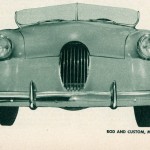
Caption: Few people would point out that this car as being a Henry J. Would you? Body was sectioned 5″ and the top was removed completely. The windshield is surrounded by a ’37 Ford frame. The grille bars are copper tubing, chrome plated. Color of the restyled car is a medium blue.
Hi Gang…
This is a question I’ve asked over and over. That is, when does a sports car become a custom. Or vice versa. Although the car in today’s article isn’t my first choice to have this debate, it certainly qualifies. There are many others that fit the bill in terms of this “question” too. And many of our fiberglass cars perfectly fit this debate. Custom Car? Sports Car? Hot Rod? The answer to this question is embedded in how you explain your car to the people that are interested in talking about it.
We’ve discussed this type of question before in a sense, but the question was “Hot Rod vs Sports Car?” Click here to review the stories in this line of debate. So let’s dig in and talk extend our original discussion….now the question changes. Are you driving or restoring a custom car or a sports car?
Read on my fellow fiberglass friends and you decide.
Sports Car or Custom?
Rod and Custom: May 1954
This Texas Built Car Presents A Question…
Text and Photos by Billy O. Boyles
A first glance at the external appearance of this car would find it automatically catalogued in the “custom” car class. Delving a little deeper into the operating performance and handling ability, however, it becomes evident that many “sports” car qualities are also present.
Being in somewhat of a dilemma on this particular subject, the author feels unable to state which category would properly fit this Henry J. Therefore, by keeping in mind as we go along some of the basic prerequisites for a sports car – lightness, power, exceptional handling qualities, and so on, as against a change of design features, not necessarily involving changes to suspension or underpinnings to make for a better handling car, you decide whether it’s a sports car or a custom type of vehicle.
Lelton Partain, designer and builder of the car, has been reworking stock automobile bodies and engines for several years, including several Fords, a Studebaker, a 1937 Cord 810, and now the Henry J. Most of these customizing jobs have been radical departures from external design of the original bodies, with a great deal of attention paid to handling qualities and power response.
All of the work on the Henry J was done by Partain, except the upholstery and seat coverings on the inside. Back about the first of this year, before his aforementioned Cord was completely finished, Partain purchased a 1951 Henry J that was slightly the worse for wear, having been rolled over several times, and towed it back to his yard to await rebuilding.
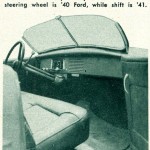
Caption: Thedash has been left neary stock but its uncluttered look carries out the theme of the car as a whole. Upholstery is red leather. The steering wheel is ’40 Ford, while shift is ’41.
The back yard in question also contained a workshop owned by Partain’s father, who also builds customs. The shop has as complete an array of equipment as almost any modern body shop. Armed with the proper equipment and the wrecked car, work began. The first thing to be done to the Henry J was the removal of nearly everything that would come off. The whole top and windshield was then cut off, the cowl moved back 16.5 inches, the quarter panels shortened 6.5 inches, and the doors 10 inches.
The area between the back of the front seat and the back of the car was filled in with flat sheet stock with all the seams welded and leaded for a smooth appearance. An average of five inches was cut from the body all around to reduce the car to the height that Partain wanted.
The window openings in the doors were welded up, and the windshield fastened to the reworked, smoothed and rounded cowl by a frame from a ’37 Ford. It was widened and reshaped to Partain’s specifications. The windshield frame is chromed and removable for competition if Partain ever desires to race the car.
The body location on the frame has not been changed although it gives that impression. The alteration of the various body components gives that effect. The hood is the same length that it was originally, the front fenders have had 16.5 inches of metal added between the wheel openings and the doors to make up the distance that the cowl was moved rearward.
The frontal area of the car has been drastically reduced. The fenders and grille on the stock Henry J curve under, on this car they curve outward. The grille was hand formed from ¼ inch copper tubing which was chromed after the proper shaping.
The body as a whole represents a smooth reworking of lines and curves, and any characteristics of the Henry J body that remain are favorably enhanced by the new styling. The wheel wells remain stock, as well as the basic fender angle and contour, from the front wheel openings back.
The bumpers are stock, and the license plate is mounted in the center of the rear bumper. The dash and instruments are stock with the uncluttered and plain dash making a pleasing appearance in conjunction with the neat look of the rest of the car.
The upholstery is red leather, with both seat and seat back rolled around the seating area. The engine was moved rearward the same distance as the cowl, 16.5 inches, and so were the frame crossmembers to facilitate installation. The car was lowered three inches all around, by blocks in the rear and by cutting the front springs.
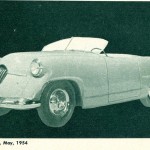
Caption: A prodigious amount of planning and hard work went into this car to make it the show piece that it is. Both cowl and engine were moved back 16.5 inches and front fenders lengthened same amount. Top of cowl is less than 36 inches high. Handling was improved by the weight relocation.
The transmission is stock Henry J, the rear end ratio is 4.11 to 1. The driveshaft was shortened by 16.5 inches and new engine mounts were necessarily fabricated. A leaf was added to each rear spring to give stiffer riding qualities – a sports car feature – but the front end remains the same except, as stated previously, for the three inch lowering operation.
The weight removed during the rebuilding process, plus the lowering of the center of gravity give this car handling characteristics it never before possessed, even with its stock front suspension. Roll is not excessive on curves and the 100 inch wheelbase car sticks to the road like the glue on a misplaced postage stamp.
As an example, Partain went for a drive the other day and, on impulse, took a right angle turn at 40 mph. Nothing happened. The stamp stuck! Another strict adherence to sports car specifications was in the steering department. The ratio has been reduced to 3 turn lock to lock in the best of sports car tradition.
This was accomplished by using a Ford Pittman arm and using a stock Henry J spindle arm. The increased Pittman arm length provides the quick ratio. The brakes on the car remain stock excepting the vented hub caps to provide a cooling blast of air. The tires are all 5.50 x 15.
The engine is virtually a stock Henry J 6. The only exceptions being .050” milled from the head and exhaust headers. Partain built his own mufflers from air vent tubes which he filled with steel wool packing. He ordered a dual intake manifold some time ago, but at this writing the eagerly awaited package had not yet arrived.
Partain says that if he keeps the Henry J engine he plans to give it the full house treatment: boring, stroking, etc. However, he is also kicking around the idea of replacing the little 6 with something much more potent than the 6 could ever hope to be.
There are the facts, so now it’s up to you. Is this a sports car or a custom? (Incidentally, the author has just convinced himself this is neither a sports car nor a custom, it’s a goodly portion of both!)
Summary:
So what do you think gang? What kind of car do you own – or did you own? I think the Woodill Wildfire is one of the neatest custom cars of all time. Or is that a sports car? You should scroll down and use the new “comments” feature and let us know what you think.
And where is this car today? It certainly was nicely made and great care was given to its design and build. I did a quick search for the car and family, and came up with just one clue – perhaps a son who lives in Texas. And where are all the other “custom cars” alluded to in the article that were built by Partain’s father in Texas? Very interesting questions here gang – and you can join in and help us solve them.
Hope you enjoyed the story, and until next time…
Glass on gang…
Geoff
——————————————————————-
Click on the Images Below to View Larger Pictures
——————————————————————-
- Caption: Few people would point out that this car as being a Henry J. Would you? Body was sectioned 5″ and the top was removed completely. The windshield is surrounded by a ’37 Ford frame. The grille bars are copper tubing, chrome plated. Color of the restyled car is a medium blue.
- Caption: A prodigious amount of planning and hard work went into this car to make it the show piece that it is. Both cowl and engine were moved back 16.5 inches and front fenders lengthened same amount. Top of cowl is less than 36 inches high. Handling was improved by the weight relocation.
- Caption: Thedash has been left neary stock but its uncluttered look carries out the theme of the car as a whole. Upholstery is red leather. The steering wheel is ’40 Ford, while shift is ’41.





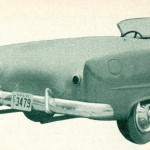
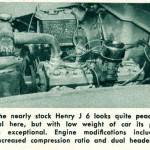

I would never use the generic term “sports car” to describe a fiberglass custom even if it was built on say a Corvette or Jaguar frame. Conversely, I would never simply call a Kellison or Woodill a “custom”. Rather, it is a “custom sports car”. The big lumbering Venus is nowhere near what I would call a sports car, although it might have been considered “sporty” in its time. It is purely a “custom car from the early 50s”.
You say tomato, I say tomahto.
Hi Jim..
Thanks for sharing your comments. The “Henry J” aspect is interesting and was used quite a bit back then – as you know. That’s one of the reasons I started a category of “specials” built on the Henry J backbone. Here’s the link to these cars:
https://www.undiscoveredclassics.com/?cat=119
And…there’s many more of these Henry J based cars to share in the future
Thanks for your comments…
Geoff
Guess I am going to weigh in on yet another term, and call it a special, certainly sporty certainly a custom, not sure it really qualifies as a sport car but certainly a special built car. With the very competent but not terribly lively Henry J mechanical component to the build, not feeling very sports car like even if the handling is sure footed.